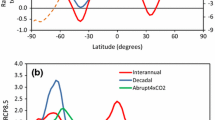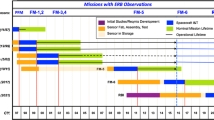Abstract
A linear analysis is applied to a multi-thousand member “perturbed physics" GCM ensemble to identify the dominant physical processes responsible for variation in climate sensitivity across the ensemble. Model simulations are provided by the distributed computing project, climate prediction.net . A principal component analysis of model radiative response reveals two dominant independent feedback processes, each largely controlled by a single parameter change. The leading EOF was well correlated with the value of the entrainment coefficient—a parameter in the model’s atmospheric convection scheme. Reducing this parameter increases high vertical level moisture causing an enhanced clear sky greenhouse effect both in the control simulation and in the response to greenhouse gas forcing. This effect is compensated by an increase in reflected solar radiation from low level cloud upon warming. A set of ‘secondary’ cloud formation parameters partly modulate the degree of shortwave compensation from low cloud formation. The second EOF was correlated with the scaling of ice fall speed in clouds which affects the extent of cloud cover in the control simulation. The most prominent feature in the EOF was an increase in longwave cloud forcing. The two leading EOFs account for 70% of the ensemble variance in λ—the global feedback parameter. Linear predictors of feedback strength from model climatology are applied to observational datasets to estimate real world values of the overall climate feedback parameter. The predictors are found using correlations across the ensemble. Differences between predictions are largely due to the differences in observational estimates for top of atmosphere shortwave fluxes. Our validation does not rule out all the strong tropical convective feedbacks leading to a large climate sensitivity.










Similar content being viewed by others
References
Allan R, Pamment A, Ringer M, Slingo A (2001) First annual report on WP4200, Tech. rep., UK Met Office
Allen MR, Stainforth DA (2002) Towards objective probabalistic climate forecasting. Nature 419:228
Allen MR, Stott PA, Mitchell JFB, Schnur R, Delworth TL (2000) Quantifying the uncertainty in forecasts of anthropogenic climate change. Nature 407:617–620
Bajuk LJ, Leovy CB (1998) Seasonal and interannual variations in stratiform and convective clouds over the Tropical Pacific and Indian Oceans from ship observations. J Clim 11:2922–2941
Bony S, Dufresne JL (2005) Marine boundary layer clouds at the heart of tropical cloud feedback uncertainties in climate models. Geophys Res Lett 32:20806–20806
Dai A, Genio ADD, Fung IY (1997) Clouds, precipitation and temperature range. Nature 386:665–666
Frame DJ, Booth BBB, Kettleborough JA, Stainforth DA, Gregory JM, Collins M, Allen MR (2005) Constraining climate forecasts: the role of prior assumptions. Geophys Res Lett 32:9702–9702
Giorgi F, Francisco R (2000) Uncertainties in regional climate change prediction: a regional analysis of ensemble simulations with the HadCM2 coupled AOGCM. Clim Dyn 16:169–182
Grabowski WW (2000) Cloud microphysics and the tropical climate: cloud-resolving model perspective. J Clim 13:2306–2322
Gregory D, Morris D (1996) The sensitivity of climate simulations to the specification of mixed phase clouds. Clim Dyn 12:641–651
Gregory D, Rowntree PR (1990) A mass flux convection scheme with representation of cloud ensemble characteristics and stability-dependent closure. Mon Weather Rev 118:1483–1506
Hahn CJ, Warren SG, London J (1996) Edited synoptic cloud reports from ships and land stations over the globe, 1982-1991
Hall A, Qu X (2006) Using the current seasonal cycle to constrain snow albedo feedback in future climate change. Geophys Res Lett 33
Ingram W (1990) Unified Model Documentation Paper no. 23: Radiation, Tech. rep., UK Met Office
Knutti R, Meehl GA, Allen MR, Stainforth DA (2005) Constraining climate sensitivity from the seasonal cycle in surface temperature. J Clim 19:4224–4233
Lau KM, Wu HT (2003) Warm rain processes over tropical oceans and climate implications. Geophys Res Lett 30
Lindzen RS, Kirtman B, Kirk Davidoff D, Schneider EK (1995) Seasonal surrogate for climate. J Clim 8
Manabe S, Wetherald RT (1975) The effects of doubling the CO2 concentration on the climate of a general circulation model. J Atmos Sci 32:3–15
Murphy JM, Sexton DMH, Barnett DN, Jones GS, Webb MJ, Collins M, Stainforth DA (2004) Quantification of modelling uncertainties in a large ensemble of climate change simulations. Nature 430:768–772
North GR, Bell TL, Cahalan RF, Moeng FJ (1982) Sampling errors in the estimation of empirical orthogonal functions. Mon Weather Rev 110:699–706
Piani C, Frame DJ, Stainforth DA, Allen MR (2005) Constraints on climate change from a multi-thousand member ensemble of simulations. Geophys Res Lett 32:23825–23825
Pope VD, Gallani ML, Rowntree PR, Stratton RA (2000) The impact of new physical parametrizations in the Hadley centre climate model: HadAM3. Clim Dyn 16:123–146
Reilly J, Stone PH, Forest CE, Webster MD, Jacoby HD, and Prinn RG (2001) Climate change: uncertainty and climate change assessments. Science 293: 430
Rodwell MJ, Palmer TN (2007) Assessing model physics with initial forecast tendencies: Application to climate change uncertainty. Q J R Meteorol Soc (submitted)
Slingo A (1989) A GCM parameterisation for the shortwave radiative properties of water clouds. J Atmos Sci 46:1419–1427
Smith RNB (1990) A scheme for predicting layer clouds and their water content in a general circulation model. Q J R Meteorol Soc 116:435–460
Smith R, Gregory D, Wilson C, and Bushell A (1997) Calculation of saturates specific humidity and large-scale cloud, Tech. rep., UK Met Office
Smith R, Gregory D, Mitchell J, Bushell A, Wilson D (1998) UM Documentation No. 26: Large Scale Precipitation, Tech. rep., UK Met Office
Stainforth DA, Kettleborough JA, Allen MR, Collins M, Heaps A, Murphy JM (2002) Distributed computing for public-interest climate modeling research. Comput Sci Eng 4:82–89
Stainforth DA, Aina T, Christensen C, Collins M, Faull N, Frame DJ, Kettleborough JA, Knight S, Martin A, Murphy JM et al (2005) Uncertainty in predictions of the climate response to rising levels of greenhouse gases. Nature 433:403–406
Tselioudis G, DelGenio AD, Kovari Jr W, and Yao MS (1998) Temperature dependence of low cloud optical thickness in the GISS GCM: contributing mechanisms and climate implications. J Clim 11:3268–3281
Weare BC (1997) Comparison of NCEP–NCAR cloud radiative forcing reanalyses with observations. J Clim 10:2200–2209
Webb MJ, Senior CA, Sexton DMH, Ingram WJ, Williams KD, Ringer MA, McAvaney BJ, Colman R, Soden BJ, Gudgel R et al (2006) On the contribution of local feedback mechanisms to the range of climate sensitivity in two GCM ensembles. Clim Dyn 27:17–38
Wu X (2001) Effects of ice microphysics on tropical radiative–convective–oceanic Quasi-equilibrium states. J Atmos Sci 59:1885–1897
Author information
Authors and Affiliations
Corresponding author
Rights and permissions
About this article
Cite this article
Sanderson, B.M., Piani, C., Ingram, W.J. et al. Towards constraining climate sensitivity by linear analysis of feedback patterns in thousands of perturbed-physics GCM simulations. Clim Dyn 30, 175–190 (2008). https://doi.org/10.1007/s00382-007-0280-7
Received:
Accepted:
Published:
Issue Date:
DOI: https://doi.org/10.1007/s00382-007-0280-7




